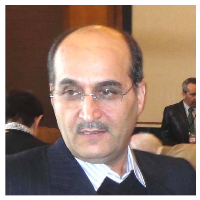Extraction of Hillsides Drainage pattern in density forest Behshahr area using Low-frequency radar
Author(s):
Article Type:
Research/Original Article (دارای رتبه معتبر)
Abstract:
Introduction
Synthetic aperture radar (SAR) systems have been widely used in the past two decades to produce high-resolution mapping and other remote sensing applications (Calabro et al. 2010; Sun et al. 2011). The ability of penetrating to the cloud , snow dry soil as well as day and-night operation made the SAR systems with more capability compared to optical imagery (after Karjalainen et al. 2012). SAR data are widely applied for several studies geophysical and geographical approach forestry and vegetation, biomass measurements, soil moisture, natural hazards and etc. (Lardeux et al. 2011,Herrera et al. 2013). The present study deal with morphological landform Identification over the area covered with dense forest. Where is the landform assessing and mapping almost appeared as big task due to difficulty of observing true the optical images. The high penetration potential of SAR signals through the vegetation cover can be obtained using the L band of the ALOS PALSAR satellite with nearly 24 cm signal wavelength (Herrera et al. 2013. Furuta et al. 2005) Furthermore, it is mention that ALOS PALSAR data is very useful for producing accurate digital elevation models (DEMs) and deformation monitoring, as well as disaster monitoring and hazard prevention. Topography is a key controlling factor in the operation of a variety of natural processes (Montgomery and Brandon 2002). Hence it needs to be quantitatively analyzed (Lague et al. 2003), to ascertain the relative efficacy of its constituents and operative mechanisms, and to gauge the response of geomorphic systems to different stimuli (Ahmed et al. 2010). Rivers are one of the most sensitive elements of the landscape (Smedberg et al. 2009). The systematic evaluation of land surfaces and drainage pattern characteristics remains as a main study object in geomorphology. Consequently in geo-morphometry (Prasannakumar et al. 2013). Digital elevation models (DEMs) have been frequently used for the above morphometric analysis of river basins through the extraction of topographic parameters and stream. The biggest advantage of DEMs over traditional topographical maps is the rehabilitee, coverage and data multiplying. Due to their wide applicability and rehabilitee, DEMs have been used in a variety of studies where terrain and drainage factors play prominent roles. The aim of this research is Extraction of Hillsides Drainage pattern in density forest area using Low-frequency radar data.
Methodology
Dense forests of Behshahr South are a rainforest which is geographically located at a latitude of 36° 25’ 30” up to 36° 43’ 30” N and longitude 53° 04’ 15” up to 53° 54’ 15” E. The Average elevation of the area is 704.58 m above mean sea level. The rainfall received over the basin area varies from 700 to 1000 mm annually. This paper provides a comparative study of different available or derived DEMs (SRTM, ASTER, ALOS-POLSAR), through extraction of stream networks and their eventual comparison. A flowchart schematically shows the methodology followed for the extraction of drainage networks from DEMs in a GIS environment (Fig. 2). The DEMs of the study area is first preprocessed through the operations of Flow Direction, sink dems and filling the data gaps, pit removal–depression filling, and finding outlet cells in an iterative manner. Pit removal and depression filling is a method of filtering the digital elevation data. This is done to overcome any data voids that may be present in the DEM tile and to also ensure proper channel network connectivity. Sometimes, there are some pixels in the continuous array of digital data where the value of the pixel is abnormally low or high in comparison to other neighbouring cells. These are known as data sinks or spikes respectively and these are inherent in any DEM. These need to be removed before carrying out any sort of analysis in the data. After extraction of drainage networks to use Digital Elevation Models, The ability of Digital Elevation Models were evaluated in the extraction of drainage networks. And in the last step, Drainage density was calculated in each of the land covers.
Results and discussion
The average elevation with a standard deviation of the study area extracted from the different DEMs have been calculated and subsequently presented in Table 2 and figure 3. The results showed that PALSAR digital elevation model has the lowest standard deviation. Figures 4,5 and tables 3,4 depict the comparisons of drainage networks derived from the different DEMs with respect to total stream lengths and Drainage density respectively. It is observed that the maximum lengths of streams and maximum area of high Drainage dendity are generated by PALSAR DEM. Integration of land use and drainage density map also showed that in PALSAR DEM, 73.62 percentage (520.97 K2) of dense forest area have been located in very high Drainage density class. While, in ASTER and SRTM DEMS only 0.033 and 0.672 percentage of dense forest area have been located in very high Drainage density class, respectively.
Conclusion
Digital Elevation Models (DEMs) have been a subject of increasing attention and utilization in the last few decades because of the relative ease in delineation, extraction and calculation of various drainage and terrain morphometric parameters from them. The present study was carried out in order to find the best possible DEM for extraction the drainage pattern in density forest area. After analyzing the different parameters derived from these DEMs, it can be said that the DEM derived from the Low-frequency radar datasets is relatively more accurate and consistent than ASTER and SRTM DEMS. The results showed that Low-frequency radar datasets have High capability for penetration through the vegetation cover and extraction of drainage patternKeywords:
Language:
Persian
Published:
quantitative geomorphological researches, Volume:7 Issue: 2, 2018
Pages:
209 to 223
magiran.com/p1923064
دانلود و مطالعه متن این مقاله با یکی از روشهای زیر امکان پذیر است:
اشتراک شخصی
با عضویت و پرداخت آنلاین حق اشتراک یکساله به مبلغ 1,390,000ريال میتوانید 70 عنوان مطلب دانلود کنید!
اشتراک سازمانی
به کتابخانه دانشگاه یا محل کار خود پیشنهاد کنید تا اشتراک سازمانی این پایگاه را برای دسترسی نامحدود همه کاربران به متن مطالب تهیه نمایند!
توجه!
- حق عضویت دریافتی صرف حمایت از نشریات عضو و نگهداری، تکمیل و توسعه مگیران میشود.
- پرداخت حق اشتراک و دانلود مقالات اجازه بازنشر آن در سایر رسانههای چاپی و دیجیتال را به کاربر نمیدهد.
In order to view content subscription is required
Personal subscription
Subscribe magiran.com for 70 € euros via PayPal and download 70 articles during a year.
Organization subscription
Please contact us to subscribe your university or library for unlimited access!




